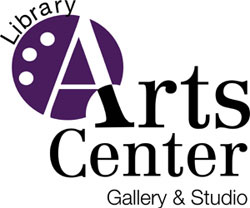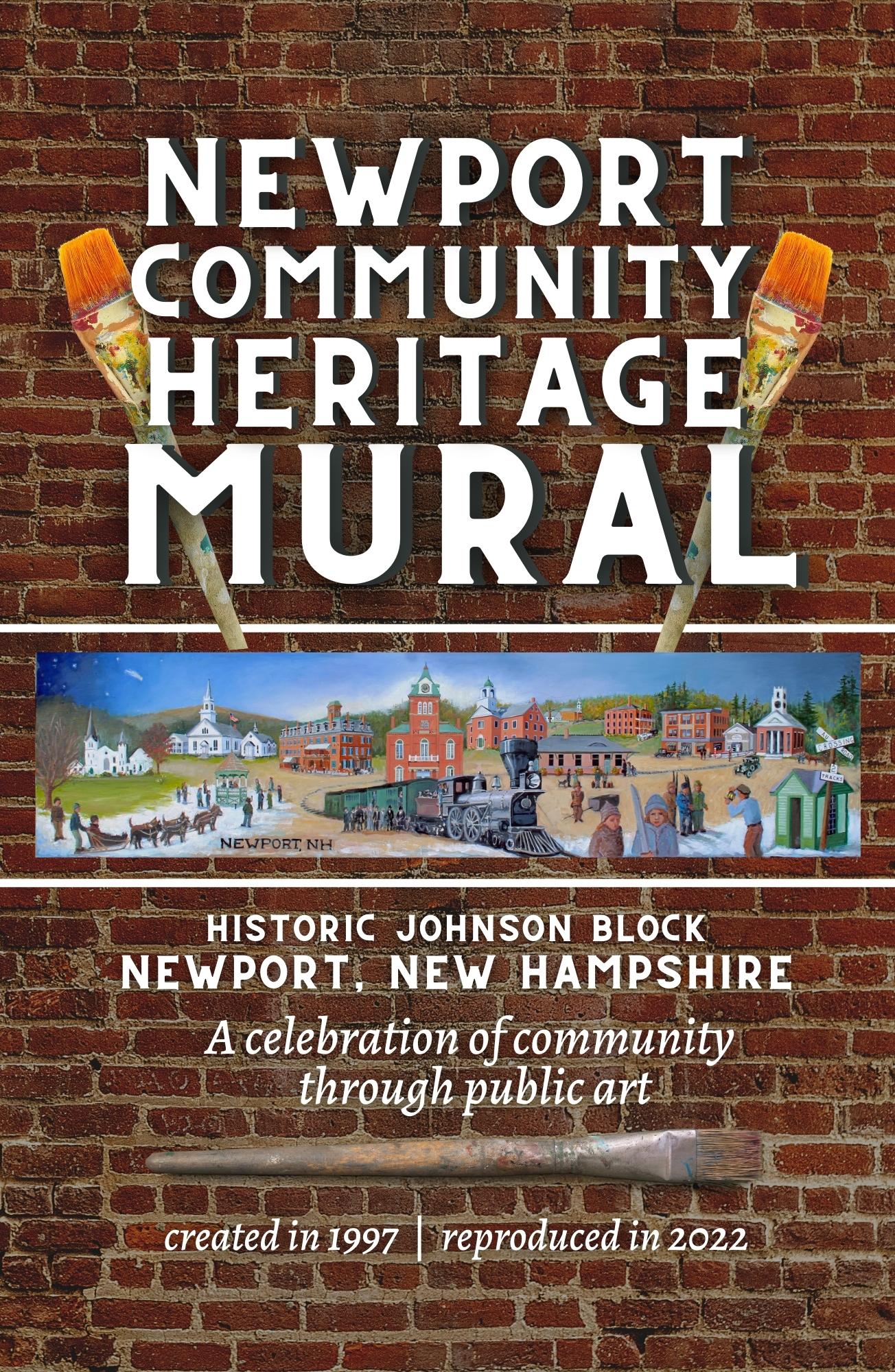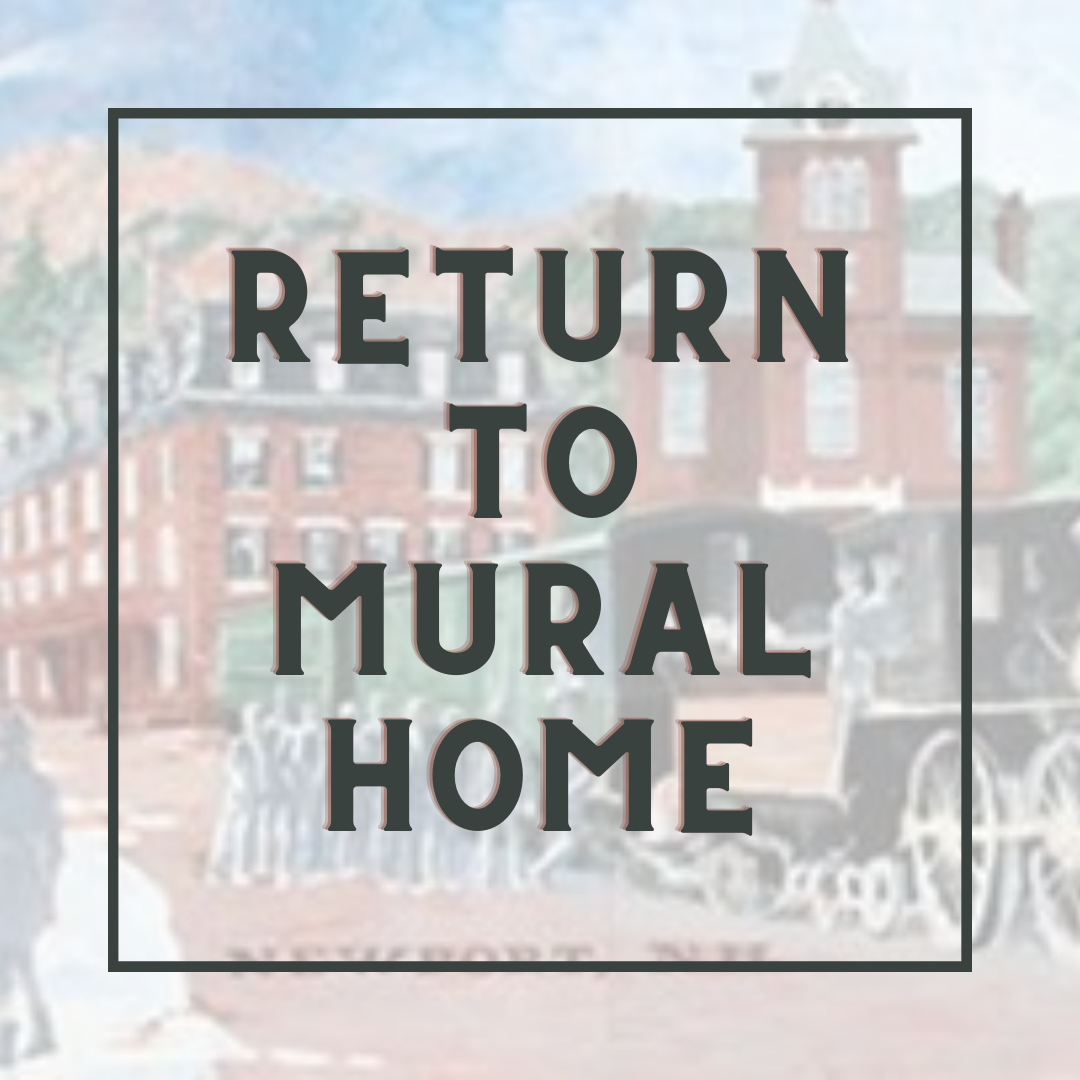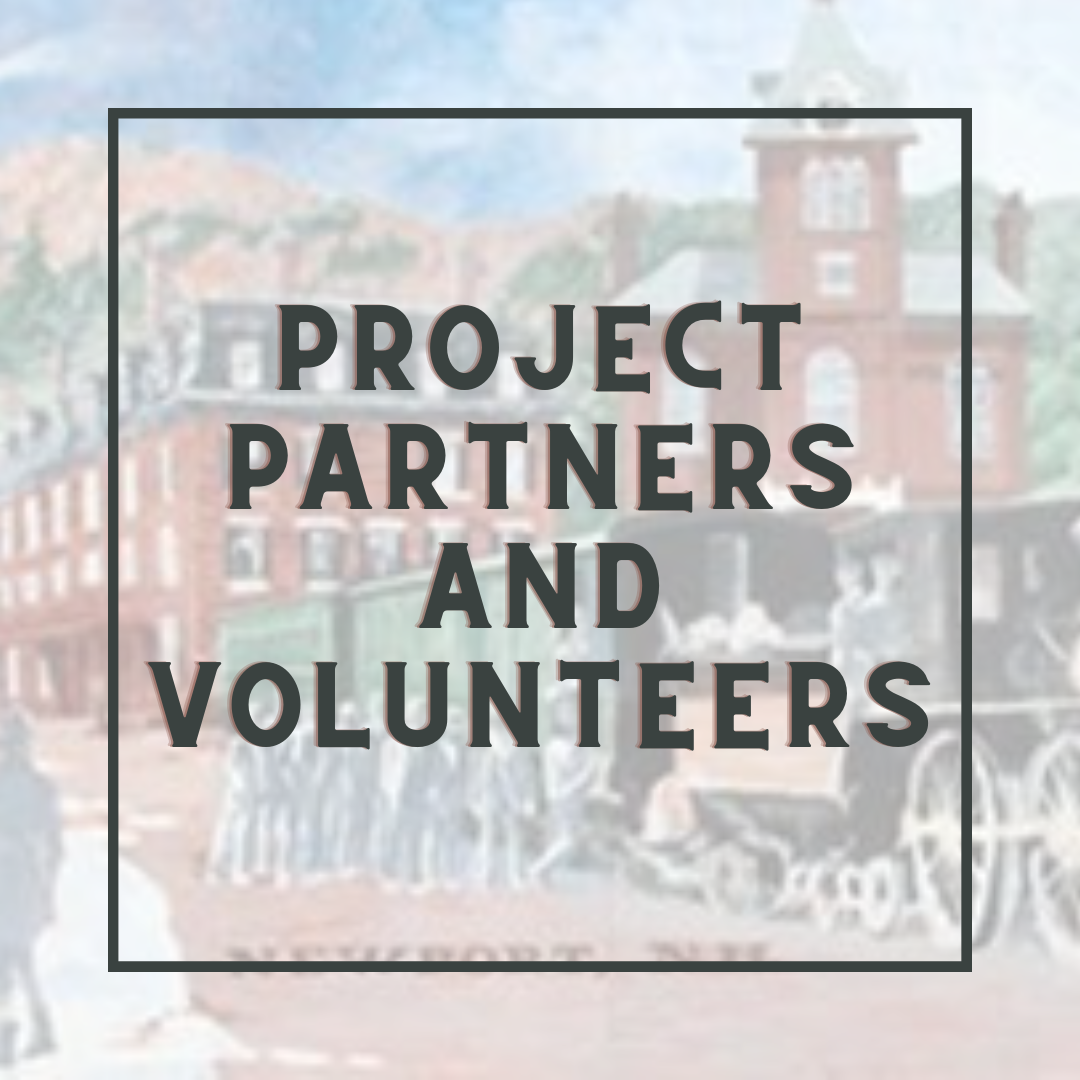Mural History
Preserving Newport's Main Street Heritage Mural
Newport’s Train Depot + Carts
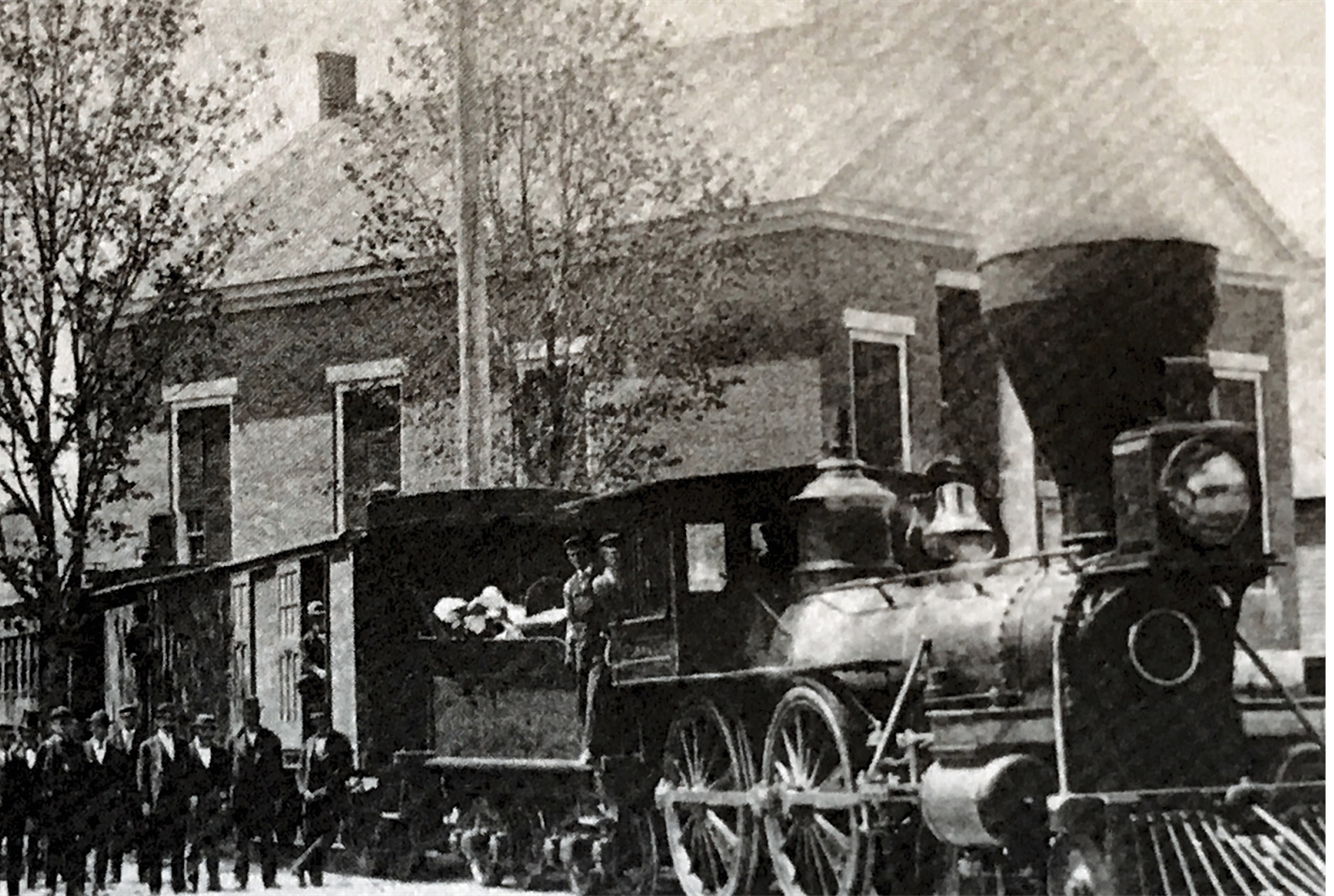
Train arriving in downtown Newport.
Explore the destinations in the Mural through the Mural Booklet!
See more information about the history of this treasured community art piece, and its present-day restoration, and learn more about the history of each of the Newport landmarks depicted in the mural.
More information about the history of each of the landmarks coming soon!
Newport Landmarks and Traditions depicted in the Heritage Mural:
-
First Baptist Church
-
Dr. David Currier House
-
Methodist Church
-
Bandstand on the Common
-
Newport House
-
Town Hall/Opera House
-
The Old Courthouse
-
Skiing in Newport and Winter Carnival
-
Empire Theater
-
South Congregational Church
-
Eagle Hotel/Eagle Block
-
First Citizens Bank (now MJ Harrington)
-
Universalist Church
-
History of Sled Dog Racing in Newport and Winter Carnival
-
Depot/Train Crossing/Flagman’s Hut
The 1997 Main Street Train Mural
On the night of November 21, 1871, the first train crossed Main Street in Newport, NH. The train named “the Franklin” was built by the Amoskeag Locomotive Works from Manchester, NH. About a year and a half before, according to Edmund Wheeler’s town history, a ceremonial groundbreaking had taken place near the passenger depot at sunrise on May 31, 1870. Crowds of people cheered as church bells rang, and cannons were fired. Two of the oldest and most respected gentlemen in town, Seth Wheeler and Dr. Mason Hatch participated in the ceremony. Wheeler struck the first pick, followed by Hatch “who wheeled the first barrow of dirt.” Regular train service from Bradford, NH west to Claremont, NH began the morning of September 16, 1872 as part of the Concord to Claremont Railroad System. This system was the internet of the time bringing visitors, citizens returning home and goods to and from other parts of the country and the world. Its importance is seen in the economic growth of Newport during the late 1800s and early 1900s. Passenger service continued until 1954, and freight service ended on September 5, 1977.
Then in 1996, Newport was selected to hold the New England Artist Trust Congress IV. This was the first time the Congress was held in NH and the first time it was located in a rural community. Patryc Wiggins and Kathy Hubert headed the committee responsible for obtaining this selection. Seven major community projects were established based on the Congress’s theme of “Culture Builds Community”; one being the Main Street Train Mural. Another mural located on Sunapee Street’s Coronis Market was completed the following year.
Three artists were selected to develop the mural, Thor Carlson, Bryony Romer and Nick Scalera. Carlson, who knew Wiggins, due to their shared interest in tapestries, would head up the project. Carlson had been a member of the National Society of Mural Painters since 1956, was a Fulbright Scholar at the Academia di Bella Artes in Florence, Italy, received a MFA from Yale University, and had received his first training with tapestry from his Finnish grandmother. Carlson had done recent projects at the Fitchburg Art Museum in Fitchburg, Massachusetts, and at St. Michael’s College in Vermont. Romer was an artist and arts administrator in Brooklyn, NY, and had worked collaboratively on community art projects. Her role here would be to organize time schedules and the groups who would paint the mural. Nick Scalera was a local artist, whose community projects included designing the Newport Bandstand.
The committee selected the train to be the focal point of the mural, mostly due to the fact that the mural would hang on the Johnson Block Building on Main Street just feet from where the train tracks crossed Main Street. The site offered a prime location for viewing. With that decision made, Scalera, being the “local” on the committee selected other buildings on Main Street which covered a wide spectrum of the historical, social, political, professional, spiritual, and social aspects of the community. The buildings spanned the 100 years of the train’s history. This mural also would feature activities important to the people of Newport like the Winter Carnival, sled dog racing and skiing. The mural’s theme was meant to serve as an educational tool for Newport residents and visitors.
The next step was for a committee of artists which not only included the three artists previously mentioned, but also local teacher Steve Giroux, who drew the scenes on 4’ X 4’ wooden panels. Carlson took the role of coach and editor, drawing on his 50 years of experiences as a muralist and teacher. Carlson purposely did not want to take on a role as painter, leaving that up to the local community. Extensive research was done by the artists using historic photos, to complete the mural.
Strong support from the community was needed for the next step in the process. During the summer of 1997, the Newport Middle and High School cafeteria was turned into an art studio. Over 120 local artists, ages 6 to 82, were involved in the project including the Newport Recreation Center Summer Program participants, local artists, Middle High School maintenance crew, an International Work Camp, Steve Tyler’s mom, and other interested adults, teenagers and visitors. A list of participants is included at the end of this document. The list was compiled by first hand accounts and a sign-in book which was on location during the painting sessions. One Newport High School student, junior Thirza Driggs, stands out as taking a leading role in the painting. Thirza was present for every day of the painting process, and she contributed to each of the 36 panels of the mural. It is believed that the painting process involved thousands of total hours of volunteerism. Articles in the local newspapers asked for
In addition to painters, local businesses contributed to the process. LaValley Building Supply provided the materials for the mural, and Lake Sunapee Bank, owners of the building, and Harrington Jewelers sponsored the project. A grant from the Wallace Readers’ Digest Fund also provided funds for this mural and other Artist Congress projects. When the school cafeteria was no longer available for painting, Gauthier and Woodards, McCrillis and Eldridge Insurance offered part of their Main Street building for the completion of the project. After three coats of varnish were added to the painting, the town of Newport donated barrels to serve as stands for the drying of the panels. Friends and family of Bryony Romer who were impressed by the community’s outpouring of support, also contributed $1,000 to the project. When the painting and varnishing was completed, a crew of Nick Scalera, Frank (Fuzz) Wiggins and Rick Bressette installed the panels onto the south facing wall of the Johnson Building, completing the process of a mural that spanned 12 feet by 48 feet. A ribbon-cutting ceremony was held in mid-September.
As stated by the Patryc Wiggins and Kathy Hubert, in a letter called “Welcome and thank you” that appeared in the News Leader, “a strategy of the Congress was to leave behind needed, lasting, treasured contributions to the community” and “The artistic integrity and community spirit expressed in the completed public work of art serves to extend honor and ownership to all for years to come.”
List of Painting Participants in the Original Main Street Train Mural – 1997
|
Andrew Andrews Michele Arrigo Janet Audette Damien Aytche Cathryn Baird T.T.Baker Scott Barton Kristin Beebe Casey Bell Ian Benson Elarin Bevilacqua Scott Blewitt Joey Bohrer Tracy Boldog Kelly Borcuk Laurie Borghi Jean Boucher Dylan Boyle John Bridgeman Rick Brissette Gwen Brooks Peter Brusco Joseph Buehler Debbie Cammarata E. Thor Carlson Adam Carpenter |
Jerry Carrier Ella Casey Brett Cossaboon Nick Clark Dina Cody Greg Collins Gilbert Corliss Brandon Currier Nicole Currier Tyler Cusanelli Brandon Deane Whitney Dearborn Taylor Dearborn Austin Dearborn Mary Dupont Justin Drew Thirza Driggs Brittany Dunn Steve Ensign Carol Ferland Jillian Fraser Amay Gallagher Roberta Giroux Steve Giroux Belisa Gorey Angela Hazan |
Andrew Hazelton Meghan Holmes Dustin Holmes Rebecca Holmes A.J. Hooper David JAnvrin Garrett Judkins Alli Kainu Eryn Kainu John Kainu Ariann Kanakis Kristie Kathan Jason Kathan Thomas Kelley Julie Kersey Carla King Alicia Koselniak Stacy Koscelniak Reuben LaFountain Cynthia Langdon Andrew Lanier Katie LaVigne Phyl LaVigne Kevin Lloyd Marty Lovely Sandy Luckury |
Cassie Magoon Elizabeth Marsh Justin Martin Kristin McBeebe Erna McCormick Elizabeth McHugh Taylor McKenney Erin McKenney James Merchant Robe Moody Kathy Neault Colleen O’Conner Roland Partlow Charles Pellerin Ricky Pollari Scott Quimby Rebecca Rice-Robbins Sis Riley Tara Rollins Tim Rollins Bryony Romer Gert Rowe Nick Scalera Jeanette Scales Julien Seredowych |
Meghan Shomphe Justin Shull Joyce Sielewicz Ed Sielewicz Terri Spanos Alyssa Spooner Kent Stetson Jessica Stevens William Sullivan Cote Swenson Crystal Swenson Sue Tallarico Caitlin Topham Patrick Towle Elroy Truell Sarah Vandiver Susanne Villar Bobbi Violette William Walker Frank Wiggins Jason Williams David Williams Brad Williams Robbie Woods Catrina Young Jimmy Younts |
Please let us know if you are one of the original participating artists and we missed you!
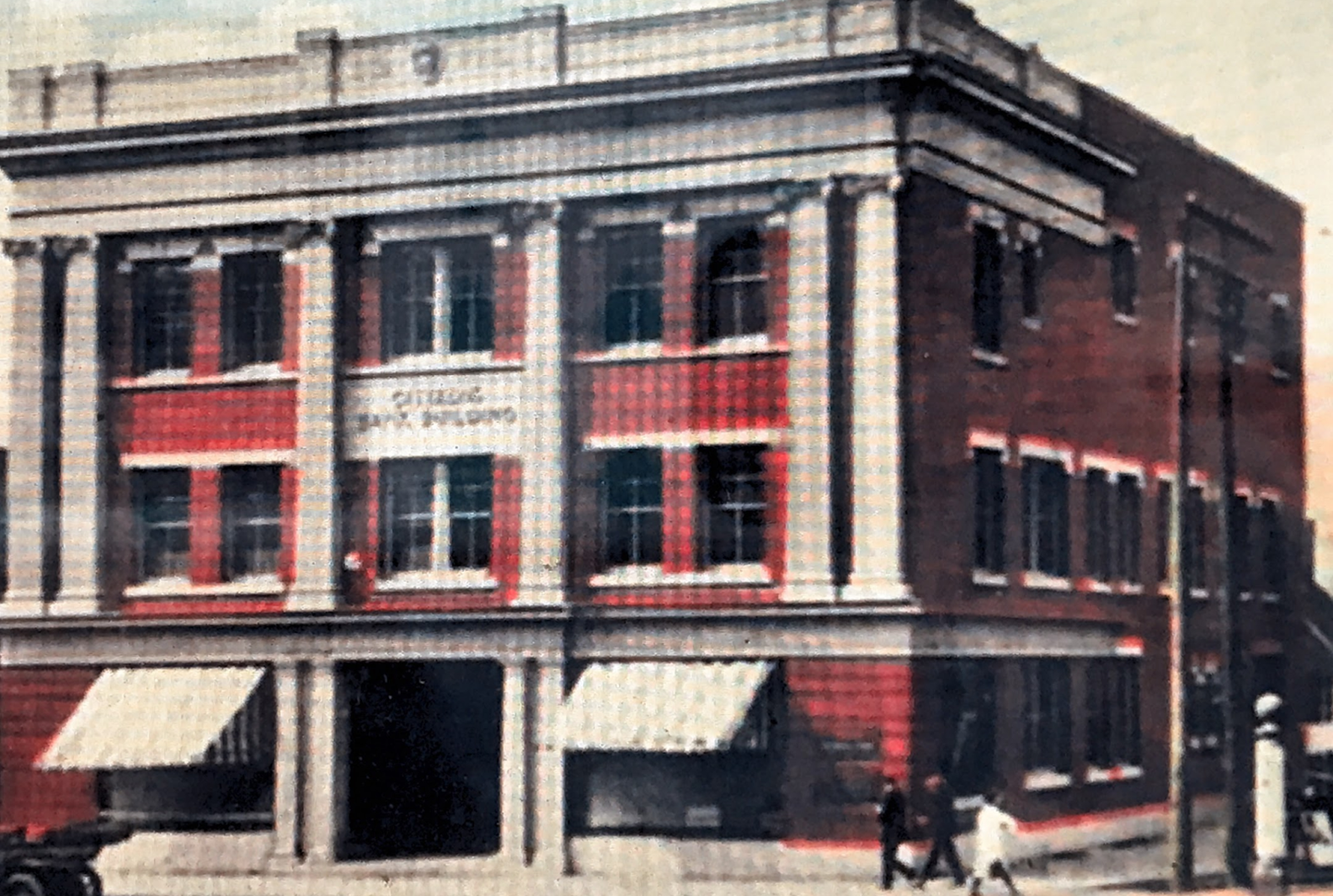
Citizens Bank Building
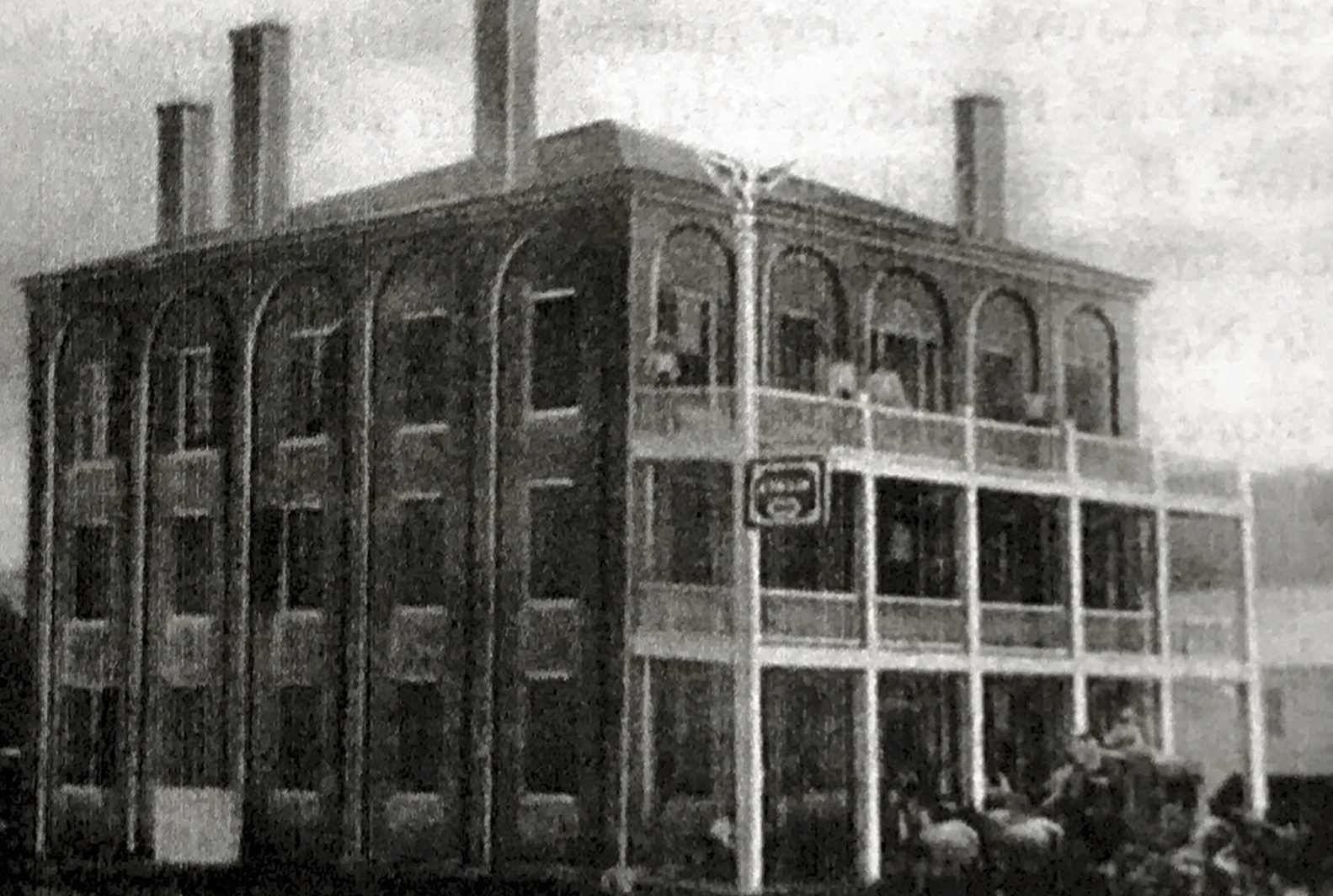
Eagle Block Hotel
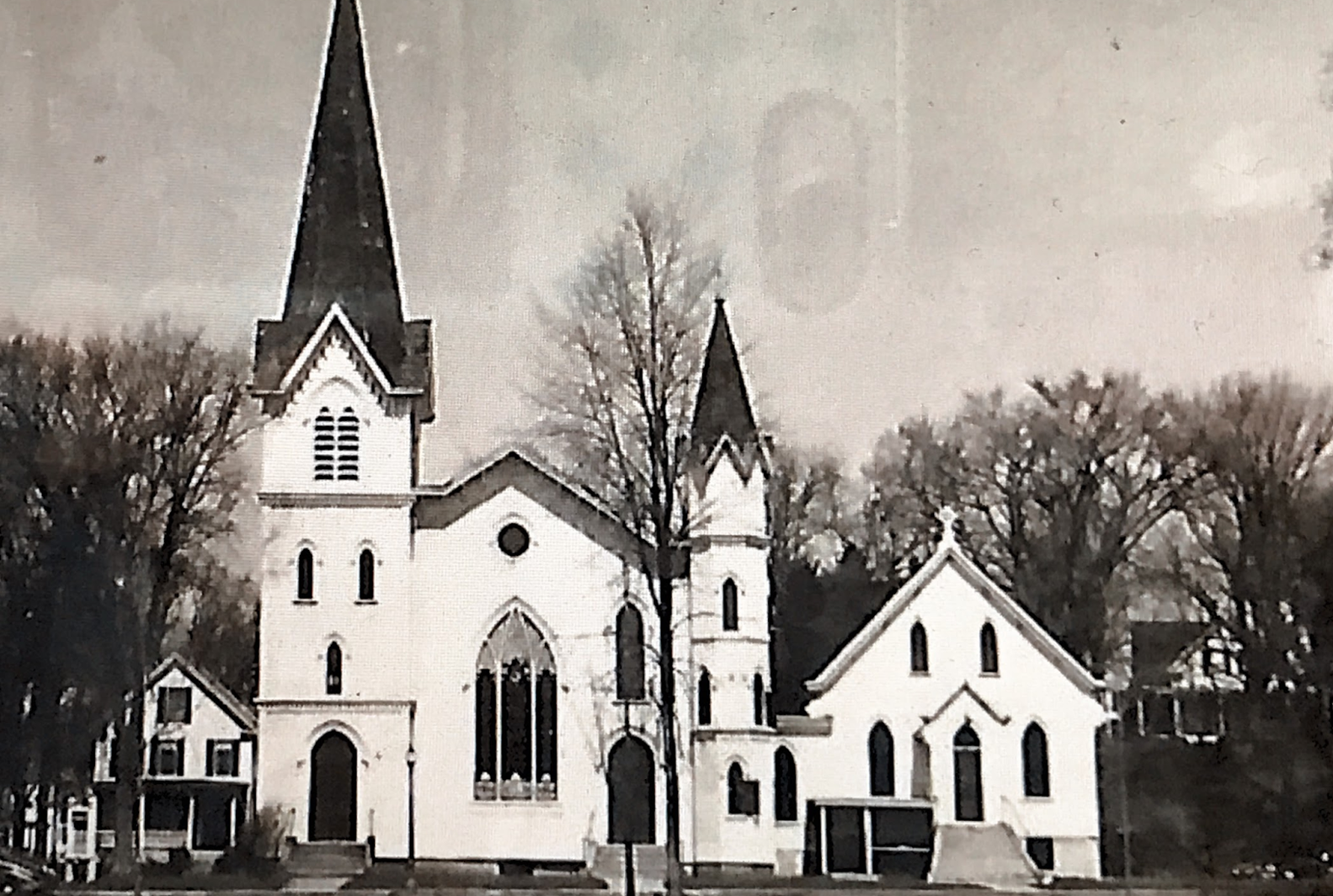
First Baptist Church on the Newport Town Common
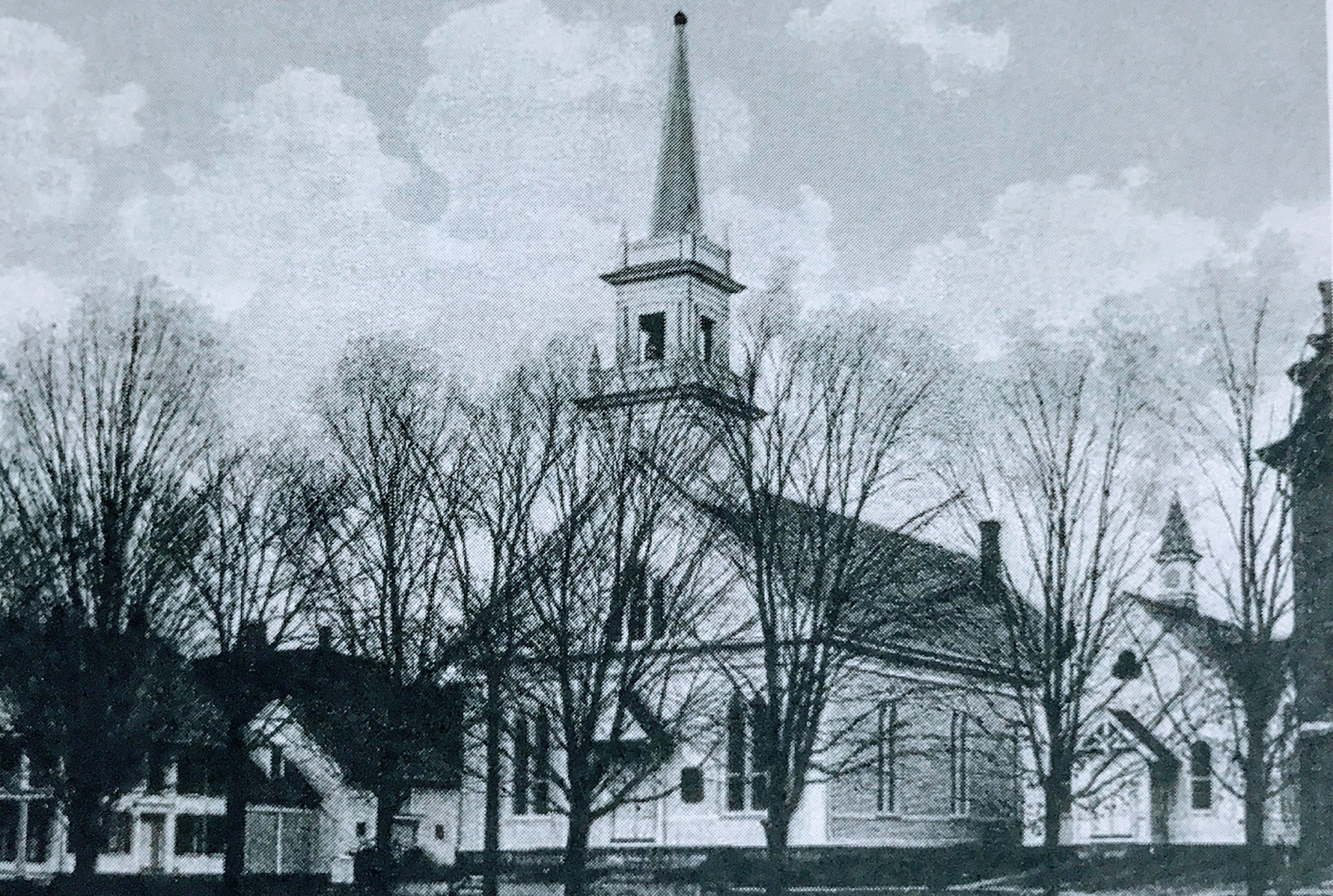
Methodist Church + Parsonage on the Newport Town Common
Sources
Larry Cote at the Newport Historical Museum for pulling together articles about the 1997 Artist Congress and Train Mural, which include “Welcome and thank you”- September 25, 1997 News Leader, and “There’s a Mural Movement Afoot in Newport, New Hampshire.”
New England Artist Congress IV Program pg. 19 by Ann St. Martin Stout
The History of Newport New Hampshire From 1766 to 1878 by Edmund Wheeler
Celebrating Community: Newport New Hampshire, 1761-2011, by Jayna Huot Hooper
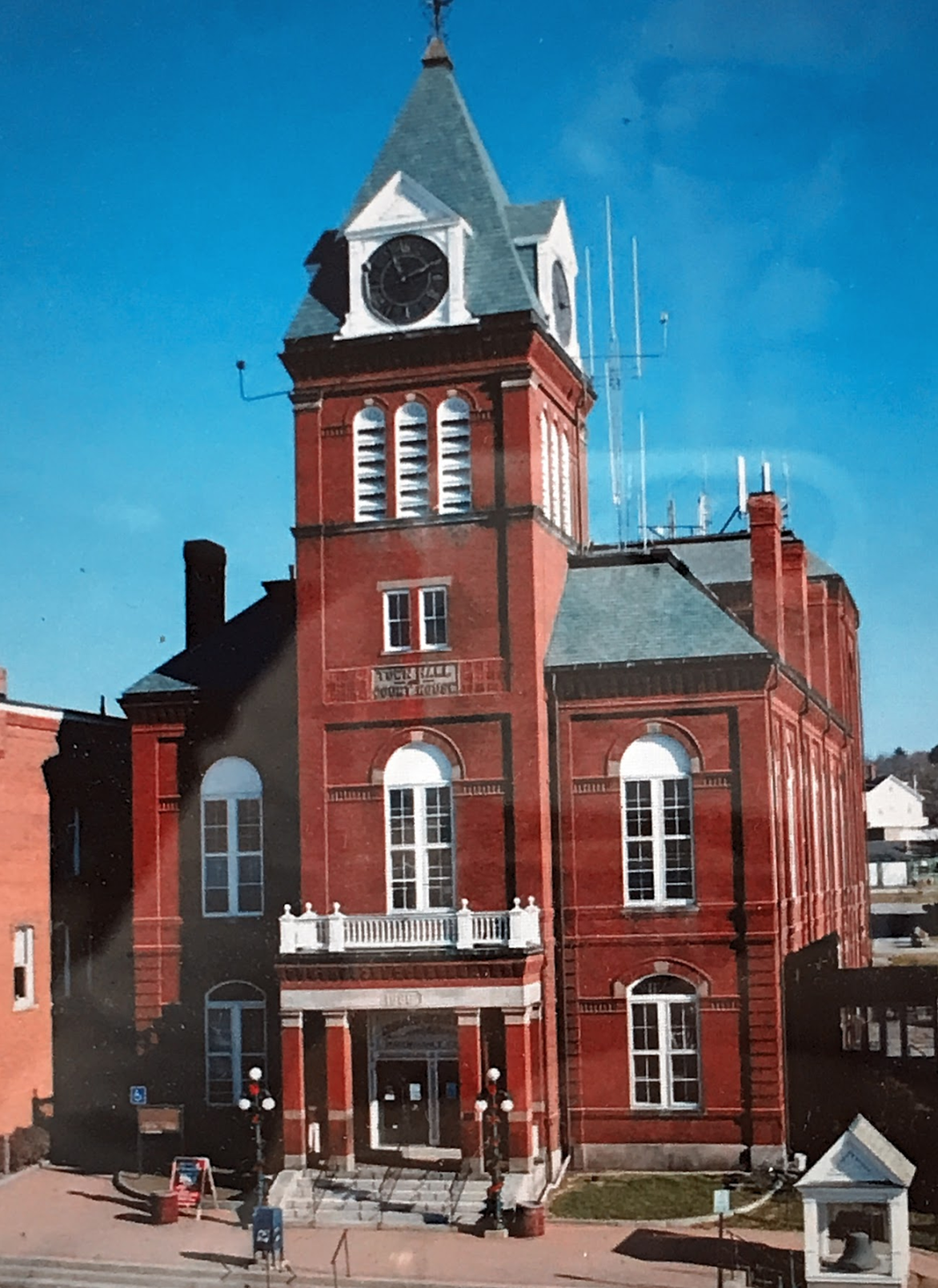
Town Hall/Newport Opera House

South Congregational Church
Mural History Quiz! - Questions + Answers
- What building on the Heritage Mural was actually moved? Answer: First Baptist Church
- The train that crossed Main Street Newport connected what two NH cities? Answer: Concord + Claremont
- The Eagle Hotel had a unique carved eagle as its sign. Where was the eagle first displayed? Answer: On a pole on the 3rd Floor Porch
- Prior to the popular Winter Carnival Queen Pageant, at which contestants are judged on poise and talent, how was the Carnival Queen selected? Answer: The Contestant who sold the most tickets + buttons.
- Name the Heritage Mural building that was described as being “peripatetic” which means “ traveling from place to place, in particular working or based in various places for relatively short periods” according to a local newspaper article. Answer: The Bandstand
- During Newport’s Bicentennial a poem/song was performed at the South Congregational Church. What famous Newporter wrote this poem for an earlier anniversary? Answer: Sarah Josepha Hale
- How did the Methodist Church in Newport get its name “The Church of the Good Shepherd”? Answer: A mural painted in the church showed Jesus as a shepherd
- At its tallest height, how many stories was the Newport House? Answer: Four stories
- An end to the almost 50 year history of sled dog racing in Newport’s Winter Carnivals was most likely due to the high cost of care for the dogs and the introduction of what sport in the 1960s? Answer: Snowmobile Races
- Which Heritage Mural building had a “twin” that was later taken down and replaced by a vital element of the community? Answer: Dr. Currier’s House
- Approximately how many people could watch a performance at the Empire Theater? Answer: 425 people
- The bell which sits in a glass case on Main Street has been located in two of the Heritage buildings. Name those buildings. Answer: Universalist Church / Opera House/Town Hall
- A home had to be moved to make room for what Heritage Mural building, in order to end a controversy? Answer: Citizens Bank Building
- Which of the Heritage Mural buildings was used as a school prior to the building of the Richards School? Answer: The Old Courthouse
